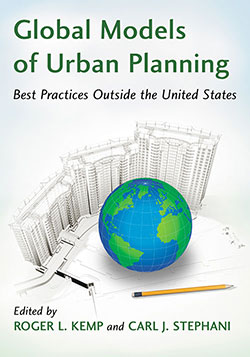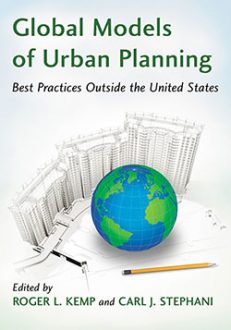Global Models of Urban Planning
Best Practices Outside the United States
$39.95
In stock
About the Book
This volume is based on an international literature search of the best urban planning practices being used in dozens of cities around the world. Such topics as green technology, conservation, infrastructure maintenance, alternative energy, downtown business districts, and recycling are covered, with many others. Additional information is provided for each community: population, location, website. There are eight appendices: periodicals bibliography, glossary, list of acronyms and abbreviations, U.S. state municipal league directory, both U.S. and international planning and development resource directories, international local government directory and U.S. state library resource directory. Thoroughly indexed.
About the Author(s)
Bibliographic Details
Edited by Roger L. Kemp and Carl J. Stephani
Format: softcover (7 x 10)
Pages: 276
Bibliographic Info: appendices, glossary, notes, index
Copyright Date: 2014
pISBN: 978-0-7864-6852-2
eISBN: 978-1-4766-1389-5
Imprint: McFarland
Table of Contents
Acknowledgments viii
Preface 1
Part I. International Urban Planning
1. Building Sustainable Communities (Barbara Moore) 9
2. Soil and Civilization (Lester R. Brown) 13
3. Creating a Livable Community (Kae Elgie) 20
4. Climate Change and Revitalization (Roger L. Kemp and Carl J. Stephani) 23
5. Taking Responsibility for Proper Growth (Richard Florida) 25
6. Improving Our Quality of Life (Tom Bakaly) 28
7. Learning from Cities in Other Countries (Robin Hambleton and Jill Simone Gross) 32
Part II. The Best Practices
8. Abitibi, Other Canadian Cities, Initiate Bioenergy Programs (Douglas Bradley) 37
9. Amsterdam, Netherlands, Other Cities, Develop “Urban Center” Exhibits (Diane Filippi and Jim Chappell) 40
10. Beijing, Other Chinese Cities, Promote LowCarbon Technologies (Xiaomei Tan and Deborah Seligsohn) 44
11. Belleville, Canada, Takes Steps to Manage Stormwater Runoff (OonSoo Ooi) 49
12. Betim, Brazil, Develops Energy Education Center for Its Citizens (Fabiana Barbi, Carla Borges and Paula Gabriela Freitas) 52
13. Bogor, Indonesia, Implements Water and Soil Conservation Programs (Ann Hardjosoesilo) 57
14. Calgary, Canada, Improves Winter Maintenance Program to Enhance Its Environment (Ryan Jestin) 61
15. Cape Town, South Africa, Creates Biodiversity Network to Protect Vegetation (Marlene Laros) 68
16. Cassowary Coast, Australia, Promotes Growth but Preserves Its Natural Assets (Cassowary Coast Regional Council) 73
17. Chiang Rai, Thailand, Uses Urban Biodiversity Program to Promote Sustainability (Anurak Chalumputch and Tharee Kamuang) 76
18. Collingwood, Canada, Works to Maintain the Character of Its Neighborhoods (Gethin Davison) 80
19. Curitiba, Brazil, Scores High on the Latin American Green City Index (Karen Stelzner) 88
20. Didsbury, Canada, Creates Citizen Recycling Opportunities (Cathy Cirko) 96
21. Ekurhuleni, South Africa, Improves Energy Efficiency in Its Public Buildings (Margarita Maria Parra) 100
22. Guangzhou, China, Achieves High-Density Sustainable Development (Karl Fjellstrom) 104
23. Jeddah, Saudi Arabia, Focuses on Social and Cultural Revitalization (Bizzie Frost and Michael Kerber) 108
24. Kingston, Canada, Involves Citizens in the Planning Process for Its Water Treatment Plant (Catherine Stutt) 112
25. Kumamoto, Japan, Uses Natural Systems for Groundwater Conservation (Yoshiko Sayama) 116
26. Manchester, England, Creates Public Places for People Rather than Cars (Larry Houstoun) 120
27. Mannheim, Germany, Connects Citizens to Smart City Network (Peter Kurz) 124
28. Mexico City Adopts Green Plan to Promote Environmental Sustainability (Silvia Marchesi) 127
29. Nagano, Japan, Successfully Fights Traffic with StateoftheArt Technology (PIARC Committee on Intelligent Transport) 131
30. Paris, France, Makes Bicycles Available to Reduce Traffic Congestion and Pollution (Bertrand Delanoe) 135
31. Quezon City, Philippines, Approves Parks Development Program to Create Green Spaces (Mahallah Adalia) 140
32. Rizhao, China, Uses Renewable Energy Technologies to Reduce Carbon Emissions (Bill McKibben) 144
33. Rome, Italy, One of the Most Walkable Cities in the World (Steve Mouzon) 149
34. Sao Paulo, Brazil, Uses Gas for Energy Project to Produce Electricity and Reduce Pollution (Lynda O’Malley) 151
35. Seville, Spain, Builds the World’s Largest Solar Power Technology Plant (Alok Jha) 156
36. Stirling, Australia, Uses Water Smart Parks to Achieve Water Conservation Goals (Don Low) 159
37. Stockholm, Sweden, Becomes the European Green Capital (Susan M. Gardner) 162
38. StrathroyCaradoc, Canada, Improves the Quality of Its Drinking Water (Louise Hollingsworth) 165
39. Sydney, Australia, Upgrades Its Public Street Furniture for Worldwide Event (Greg Maddock) 169
40. Takatsuki, Japan, Develops New Community Housing for Its Aging Population (Jim Lee and John Loomis) 172
41. Toronto Uses a Business Improvement District to Enhance Its Downtown (Lawrence Houstoun) 176
42. Trang, Thailand, Integrates Biological Conservation into Its Urban Planning Process (Athorn Ukkati and Tharee Kamuang) 181
43. Tunis, Tunisia, Confronts Challenges to Promote Sustainable Development (Julius E. Coles) 185
44. Vancouver, Canada, Takes Steps to Protect One of Its Wild Animals (Robert Boelens) 190
45. Vaughan, Canada, Undertakes Study to Assess the Benefits of Public Green Spaces (Marc Lalonde) 195
46. Waterloo, Canada, Works with Citizens and Students to Improve Their Community (Michael Fox) 198
47. Yokohama, Japan, Uses Tax Incentives to Preserve Private Green Spaces (Michie Kishigami) 202
Part III. The Future
48. Cities Can Change the World (Christopher Hire) 207
49. Energy Options During the Coming Years (David J. LePoire) 213
50. Renewable Energy Will Reduce Pollution (Carl E. Schoder) 218
51. Successful Transformation Is the Goal (Paul Lukez) 224
52. Bicycles, Citizens and Urban Centers (Lawrence Houstoun) 228
53. Urban Planning and College Campuses (John Dew) 233
54. Cities, Their Goals and Our Future (Bertrand Delanoe) 237
Appendices
A. Periodicals Bibliography 241
B. Glossary 242
C. Acronyms and Abbreviations 246
D. State Municipal League Directory 247
E. National Planning and Development Resource Directory 249
F. International Planning and Development Resource Directory 251
G. International Local Governments Resource Directory 252
H. State Libraries Directory 253
About the Editors and Contributors 255
Index 259
Book Reviews & Awards
“most of the pieces presented here are inspiring”—ProtoView.





